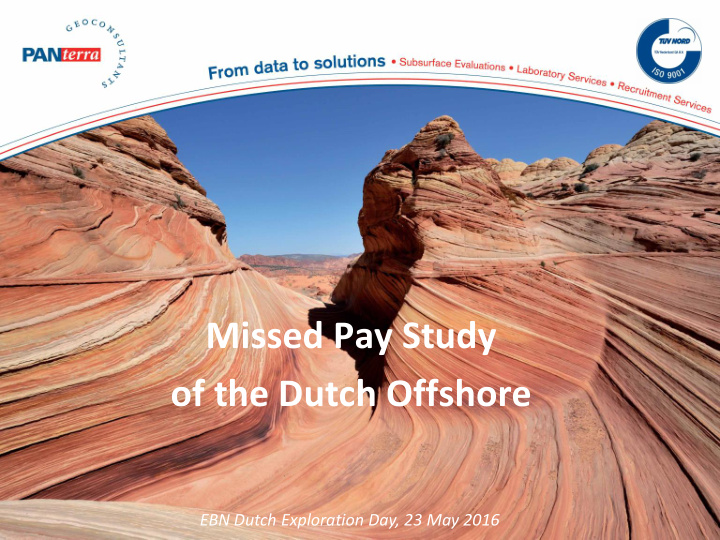



Missed Pay Study of the Dutch Offshore EBN Dutch Exploration Day, 23 May 2016
Why Missed Pay study in the Netherlands? ± • Many “unsuccessful” exploration wells – Classified as dry – Significant shows – Tested hydrocarbon accumulations. • Non-target reservoirs overlooked • Dense, aging infrastructure • Attractive small fields policy • Public availability of well and seismic data • Many conventional reservoirs in different geological settings 2 0 50 100 200 Km 2
Scope • Missed pay study of “ unsuccessful ” exploration and appraisal wells • Use all public available (NLog) well data – Electrical logs – Mud and composite logs – Drilling, geological well reports – Core, pressure, test data • Visual review includes all conventional reservoirs • Petrophysical evaluation of zones of interest • Classification of reservoirs and wells 3 3
Study areas and well selection B Well selection criteria: • Open or fallow acreage A • Exploration wells C • 10 km from infrastructure D F Six study areas based on: E • Basin geography • Infrastructure 4 Adapted from De Jager, 2007 4
Deliverables • Missed pay report per well and area • Petrophysical interpretation of zones of interest • IP and Petrel database with wells and logs • Excel database of petrophysical results and classifications • Core database • Pressure database • ArcGIS database with all wells, classifications and maps 5 5
Well classification vs. NLOG status Class 1: Hydrocarbons at surface Class 2: Hydrocarbons by logs or RFT pressures combined with shows Class 3: Good shows Class 4: Minor shows Class 5: Dry well 6 6
Example reservoir map Class 1 Class 2 Reservoir classifications Class 3 plotted on reservoir Class 4 Class 5 depth map Interval not present Displayed classifications are not real, this is an example of what a reservoir map could look like. 7 7
Example result • Old well • NLOG Classification: Conductivity GR Resistivity Shows • Gas shows in 100 m thick sandstone • DST: Gas flow 100,000 m 3 /d • Updip potential 8 8
Recommend
More recommend